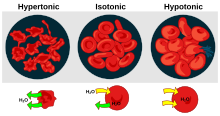Structural Biochemistry/Membrane Proteins/Passive Transport

Passive Transport Molecules have a natural tendency to move and spread out evenly in any available space. This property is called diffusion. An example would be a drop of dye in a section of a beaker separated by a permeable membrane. In this case, the dye, although the molecules move randomly, would have a net movement across the membrane such that the concentration of dye on both sides would be equal. At that point, an equilibrium would be established with the same amount of dye molecules moving across the membrane in both directions. In other words, the natural tendency of any substance is to migrate down its concentration gradient.
The diffusion of a substance across a biological membrane is called passive transport because the cell does not have to expend energy to make it happen. The concentration gradient itself represents potential energy and drives diffusion. However, membranes are selectively permeable and therefore have different effects on the rates of diffusion of various molecules. In the case of water, aquaporins allow water to diffuse very rapidly across the membranes of certain cells. The movement of water across the plasma membrane has important consequences for cells.
Types of Passive Transport
[edit | edit source]
Osmosis is a form of passive transport which involves the diffusion of water through the lipid bilayer with the use of aquaporins. However, since this is passive transport with the diffusion of water through the concentration gradient, three scenarios should be established. The first is in an isotonic solution where the concentration of water inside the cell is the same as the concentration outside the cell. In this case, since there is equilibrium, the net movement of water across the permeable membrane is the same. Therefore the cell remains unaffected. The second is in a hypotonic solution where water concentration outside the cell is greater (solute concentration lesser) than the concentration inside the cell. In this scenario, water would diffuse down its concentration gradient and into the cell, thereby causing the cell to burst. The last is in a hypertonic solution where the water concentration is lesser (solute concentration greater) than the concentration inside the cell. In this case, water rushes out of the cell thereby causing the cell to shrink. There are many organisms that live in either hypertonic or hypotonic environments and each have special adaptations for osmoregulation, or control of water flow. For example, Paramecium lives in a hypotonic environment. The protist has adapted by having a plasma membrane which is less permeable to water, thereby limiting the rate at which water enters the Paramecium. In addition, the cell is equipped with a contractile vacuole which literally pumps water out of the cell at the same rate at which it enters the cell.

Facilitated Diffusion is another form of passive transport where many polar molecules diffuse with the help of integral proteins in the lipid bilayer. The two main types of this kind of transport are ion channels and gated channels. In the case of ion channels, the protein which spans the lipid bilayer has a channel with polar R-group amino acids which allow small polar molecules to passively diffuse down their concentration gradient and into the cell. In the case of gated channels, the protein binds a molecule which causes an alteration to its 3D shape opening it up to the inside of the cell. Then, the molecule is released into the cell and the protein opens up again to the outside of the cell. In this method, the molecule still diffuses down its concentration gradient, albeit with the help of a carrier protein.

Filtration is another type of passive transport, and refers to the movement of water and other molecules across the cell membrane due to hydrostatic pressure generated by the cardiovascular system. Which molecules are permitted to pass through the membrane depends largely on the size of the molecules compared to the membrane pores. For example, the membrane pores of the Bowman's capsule in the kidneys are very small, and thus only albumins (one of the smallest proteins) may be permitted to pass through the membrane. In contrast, the membrane pores of liver cells are very large and allow a variety of molecules to pass through the membrane and be metabolized.
